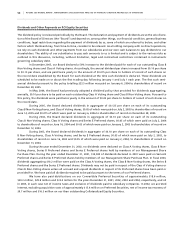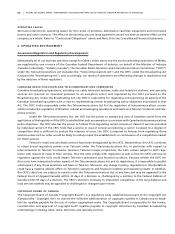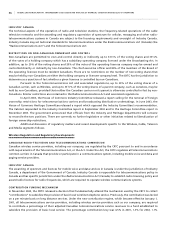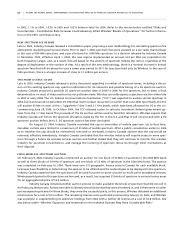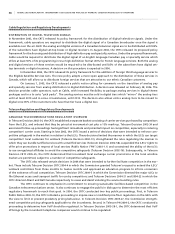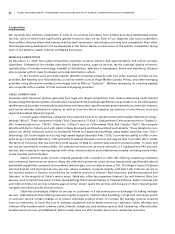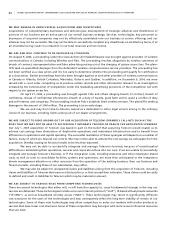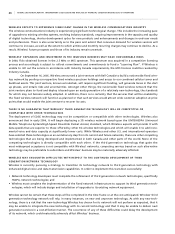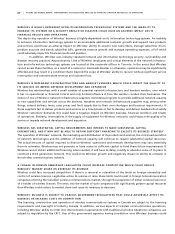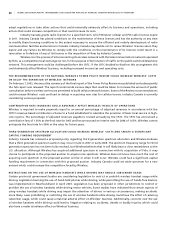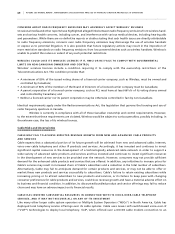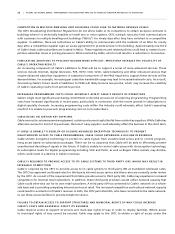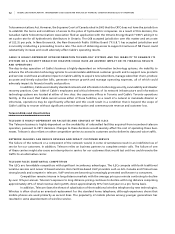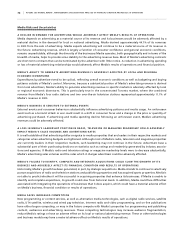Rogers 2005 Annual Report Download - page 67
Download and view the complete annual report
Please find page 67 of the 2005 Rogers annual report below. You can navigate through the pages in the report by either clicking on the pages listed below, or by using the keyword search tool below to find specific information within the annual report.
63 ROGERS 2005 ANNUAL REPORT . MANAGEMENT’S DISCUSSION AND ANALYSIS OF FINANCIAL CONDITION AND RESULTS OF OPERATIONS
OU R FI N AN C IA L LE V ER A GE M AY HA V E A D VE R SE CON S EQ U EN C ES
Our substantial debt may have important consequences. For instance, it could:
• Make it more difficult for us to satisfy our financial obligations;
• Require us to dedicate a substantial portion of any cash flow from operations to the payment of interest and principal
due under our debt, which will reduce funds available for other business purposes;
• Increase our vulnerability to general adverse economic and industry conditions;
• Limit our flexibility in planning for, or reacting to, changes in our businesses and the industries in which they operate;
• Place us at a competitive disadvantage compared to some of our competitors that have less financial leverage; and
• Limit our ability to obtain additional financing required to fund working capital and capital expenditures and for
other general corporate purposes.
Our ability to satisfy our obligations and to reduce our total debt depends on our future operating performance and
on economic, financial, competitive and other factors, many of which are beyond our control. Our business may not
generate sufficient cash flow and future financings may not be available to provide sufficient net proceeds to meet
these obligations or to successfully execute our business strategies.
WE M AY EX P ER I E NC E A D VE R S E E FF E CT S DU E T O EX C HA N GE RAT E A N D I NTE R ES T R A TE F LU C TU A T IO N S
Nearly all of our business is transacted in Canadian dollars. Accordingly, we are exposed to foreign exchange rate risk on
our U.S. dollar-denominated debt. The exchange rate between Canadian dollars and U.S. dollars, although historically
less volatile than those of certain other foreign currencies, has varied significantly over the last three years. Foreign
exchange and interest rate fluctuations may materially adversely affect our financial performance or results of operations.
For a more complete discussion on the impact of exchange rate and interest rate fluctuations, see the section entitled
“Interest Rate and Foreign Exchange Management”.
RE G U LA T OR Y C H A NG E S C OU L D A D VE R SE L Y A F FE C T O U R R ES U LTS OF OP E RAT I ON S
Substantially all of our business activities are regulated by Industry Canada and/or the CRTC, and accordingly our results
of operations on a consolidated basis are affected by changes in regulations and by the decisions of these regulators.
This regulation relates to, among other things, licensing, competition, the cable television programming services that
we must distribute, the rates we may charge to provide access to our network by third parties, resale of our networks
and roaming on to our networks, our operation and ownership of communications systems and our ability to acquire an
interest in other communications systems. In addition, our cable, wireless and broadcasting licences may not generally
be transferred without regulatory approval. Changes in the regulation of our business activities, including decisions by
regulators (such as the granting or renewal of licences or decisions regarding services we must offer to our customers),
or changes in the interpretations of existing regulations by courts or regulators, could adversely affect our consolidated
results of operations.
RE S T RI C TI O NS O N N ON - CA N A DI A N O WN E R SH I P A ND C ON T RO L MA Y A D VE R SEL Y A F FE C T O U R C OS T OF CA P IT A L
Our regulated subsidiaries must be Canadian-owned and controlled under requirements enacted or adopted under the
Broadcasting Act, the Telecommunications Act and the Radiocommunications Act. The requirements generally provide
that Canadians must own at least 80% of the voting shares of the regulated entities that, at least 80% of the members
of the Board of Directors must be Canadian, and that the entities must not be controlled in fact by non-Canadians. In
addition, no more than 331⁄3% of the voting shares of a parent company, such as RCI, may be held by non-Canadians and
the parent company must not be controlled in fact by non-Canadians. These restrictions on non-Canadian ownership
and control may have an adverse effect on us, including on our cost of capital. Our Articles and the Articles of Wireless
contain provisions which constrain the issue and transfer of certain classes of shares, including our Non-Voting shares,
for the purpose of ensuring that we and our subsidiaries remain eligible to hold licences or to carry on businesses which
are subject to non-Canadian ownership and control restrictions.


